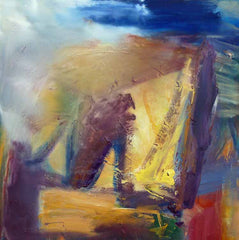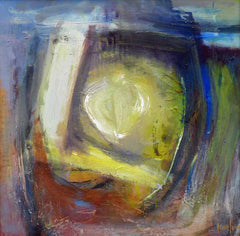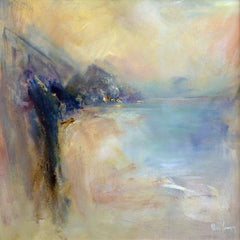How to Appreciate Abstract Art
 Watching people in galleries, I have observed that, despite much arty-farty talk and gesticulation, it is only a minority that really have the art of appreciating abstract art – the real art of abstract art appreciation! (Or would it be more appropriate to call it a skill?) Maybe it’s like many other life skills which some seem to be born with, but others of us have to learn and acquire through a process of self education? Let me give you my personal take on this, it might be of some use.
Watching people in galleries, I have observed that, despite much arty-farty talk and gesticulation, it is only a minority that really have the art of appreciating abstract art – the real art of abstract art appreciation! (Or would it be more appropriate to call it a skill?) Maybe it’s like many other life skills which some seem to be born with, but others of us have to learn and acquire through a process of self education? Let me give you my personal take on this, it might be of some use.
I feel that the majority of people when looking at abstract art, (or at art generally), are actually looking for something in pictures. So when they see, for example, the way a landscape artist produces certain realistic effects with skillful use of paint, or maybe a particular nuance of reality in a landscape painting or a portrait, which touches off a memory of what they have experienced, then they are pleased, or maybe even thrilled. It touches something within them that they are in some way looking for, and the experience of looking at the picture confirms something of themselves that they are seeking to satisfy – confirms the world as they know it. We could say it touches a sentiment within, and then becomes an outer manifestation of that inner sentiment. They can then really love that picture – and even wonder if the painting's for sale! There is nothing at all wrong with this approach to looking at works of art, (except that it doesn’t really work for abstract art)!
 However I feel that the majority of people who are looking in this way, are in fact missing out on so much more, which would be readily available to them should they but recognise the possibility of another way of looking. Along with this way of looking comes a new way of understanding. What does it mean to understand? We have come to believe that understanding takes place through the rational intelligence, what we might call a left brain approach. But in this mode we have become closed off to anything that does not fit into the neat pigeon-holes we have prescribed in advance for what we might label as ‘new information’, whether this be in the form of intellectual ideas, music, or the visual arts. It is perhaps the same sense of organisation with which we like to order our lives. So when we say ‘I understand’ we are probably referring to the same mode of intelligence that we would apply to a mathematical formula, or the specifications of a computer. In other words our concept of understanding is limited to grasping something intellectually with the fingers of our mind. However, if this is how you have understood Art so far, (and thus found little place for the abstract), I hope you may be willing to expand your thinking to what might be for you a revolutionary way of understanding.
However I feel that the majority of people who are looking in this way, are in fact missing out on so much more, which would be readily available to them should they but recognise the possibility of another way of looking. Along with this way of looking comes a new way of understanding. What does it mean to understand? We have come to believe that understanding takes place through the rational intelligence, what we might call a left brain approach. But in this mode we have become closed off to anything that does not fit into the neat pigeon-holes we have prescribed in advance for what we might label as ‘new information’, whether this be in the form of intellectual ideas, music, or the visual arts. It is perhaps the same sense of organisation with which we like to order our lives. So when we say ‘I understand’ we are probably referring to the same mode of intelligence that we would apply to a mathematical formula, or the specifications of a computer. In other words our concept of understanding is limited to grasping something intellectually with the fingers of our mind. However, if this is how you have understood Art so far, (and thus found little place for the abstract), I hope you may be willing to expand your thinking to what might be for you a revolutionary way of understanding.
To ‘understand’ literally means ‘to stand under, or below’. If we could imagine that one person is stood up to speak, then the other somehow puts himself under the speaker metaphorically speaking! What would this mean for the under-standing one? Surely it would mean that person will really be listening, really be open to whatever the speaker was communicating. It is possible that 80% of communication goes on underneath what is being said, so trying to get your head around what’s being said is only a small part of understanding, maybe the least important part. To get one’s head around a subject actually leaves out the majority of the body for a start, and it’s usually what is not being said that requires the most attention from us, especially in close communicative situations. (I trust you are still with me here?). To really understand another person often requires us to almost ignore what is being stated in favour of a deeper understanding of those emotions underlying the words. This is one important aspect of emotional intelligence, to really listen to a person, what they are communicating, both in word, and more importantly in the silence between the words. When we are able to do this n our relationships we can be happy that we are exhibiting a maturity that encompasses emotional intelligence, as well as our intellectual intelligence. What does all this have to do with abstract art? Well in a way, a picture is a form of communication from one person to another. In fact, we could go beyond visual art and incorporate all the many forms of artistic expression in both two and three dimensions, plus all auditory and other sensory experiences. All of these in some way require our understanding, if we are to actually receive these communications. In order to do this effectively, and really get the message, we might have to entirely leave aside our preconceived understanding of art, and really allow the work to speak to us directly. For some this just comes naturally, but for others it may require some effort. Maybe effort is the wrong word, as what we are talking about is ceasing to put any effort into understanding, but rather to allow oneself to under-stand, to stand under the communication we are considering.
 What does this take? It takes humility for a start. A proud person, for example, will never really understand – as their pride stands in the way. It also takes vulnerability, to allow oneself to be fully open to another person without having to control the input by way of pigeon-holing information into boxes such as ‘what I like’, ‘what I don’t like’, ‘what I don’t understand’, ‘what I find offensive’, ‘what I don’t call art’, ‘what a child could have done with his eyes closed’, et cetera. While such boxes exist in our mind we will not be open to new input, as we will have nowhere to shove it! A decision to burn all those boxes would be a great start to real art appreciation, including abstract art. In fact, better to decide now to leave your head out of it altogether! Better to allow your heart to respond, your stomach, your genitals, or your whole body, rather than restrict everything to the head with its prejudgments and prejudices.
What does this take? It takes humility for a start. A proud person, for example, will never really understand – as their pride stands in the way. It also takes vulnerability, to allow oneself to be fully open to another person without having to control the input by way of pigeon-holing information into boxes such as ‘what I like’, ‘what I don’t like’, ‘what I don’t understand’, ‘what I find offensive’, ‘what I don’t call art’, ‘what a child could have done with his eyes closed’, et cetera. While such boxes exist in our mind we will not be open to new input, as we will have nowhere to shove it! A decision to burn all those boxes would be a great start to real art appreciation, including abstract art. In fact, better to decide now to leave your head out of it altogether! Better to allow your heart to respond, your stomach, your genitals, or your whole body, rather than restrict everything to the head with its prejudgments and prejudices.
What I am saying applies also very much to music. It continues to make me smile when I hear DJs on the radio ask someone what sort of music they like, and they reply ‘Oh I like it all! Everything from Abba to Status Quo, from the Spice Girls to Guns and Roses. Wow! What a range of appreciation! That’s kind of like a minuscule slice of a very large cake, don’t you think? Where does Stravinsky come in that wonderfully all embracing scale of sublime appreciation? And all those wonderful ‘muva-f**kin nigga’ songs? And what about Goa Trance, Puccini, Cradle of Filth, or Doris Day? Or Miles Davis or Eskimo throat singing, and all that eclectic stuff? There is a saying in life-coaching that whatever it is you are resisting, that is where you need to go. .Okay your personal preference may not at all times include all of the above music, but I’m referring to resistance, or closing down to a huge range of artistic input because it gets shoved into a box labelled ‘not understood’ or ‘not familiar’ so then interpreted as: ‘not liked.’! For a change, try opening up to a form of music you have really hated up to now. Go on, I dare you! And back to our original subject, abstract art, why not decided to take a long look at a piece of work that you would up to now have dismissed because you don’t understand it, and look at it for as long as it takes not to have any thoughts about it. Only when your thoughts cease about the piece can the communication really take place, because only then are you open and ready to receive. If you don’t yet have the skill, the truly passive way of looking at art is really worth persevering with, I can assure you. Before long you will find yourself being touched, or even really moved by works of art (including abstract art) that you would have not long ago dismissed totally. Anyway, that’s my personal take on abstract Art appreciation! Thanks for giving it your time, and I hope it will have been of some benefit. If not, that’s okay too, we’re all different.
(Steve Slimm 2006)
